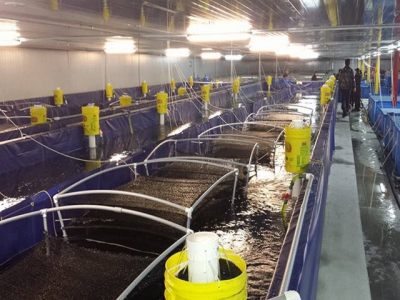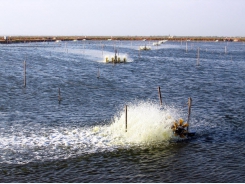The Sahara Desert and The Midwest Have One Thing in Common: Shrimp

Serious problems plague the global farmed shrimp industry. Modern day slavery, persistent diseases, and habitat destruction are chief among them.
Courtesy Dairyland Shrimp
But here’s a bit of good news: There’s a growing movement to raise shrimp using a method that avoids a dangerous cocktail of pesticides, antibiotics, bad bacteria, and all the other negative consequences of high-intensity fish farming.
And, strangely enough, farms using this highly-touted prawn aquaculture system are opening where you’d least expect them: the Sahara Desert.
Last January, Algeria celebrated the official dedication of its Shrimp Cultivation Research Center, a project funded and organized by the South Korean government as part of a international development program. The facility is the size of 12 soccer stadiums (more than one million square feet), and since launching this past October, has produced more than one thousand pounds of Pacific white shrimp product in this arid climate.
Shrimp is an expensive protein in Algeria: One kilogram costs 10 percent of the average monthly wage. The goal of the center is to offer affordable access to shrimp year-round, and, according to South Korean news reports, the Shrimp Cultivation Research Center plans to open dozens more Saharan farms in the near future.
The idea of a desert shrimp farm clearly raises questions: Where does the water come from and how is the process not completely wasteful? The Algerian shrimp farm taps a salty water source, which shrimp need to survive, from deep below the Sahara. Using a fairly recent innovation call biofloc, the farm recycles 99 percent of the water it sucks up from the desert aquifer.
The idea of a desert shrimp farm clearly raises questions: Where does the water come from and how is the process not completely wasteful?
Biofloc is promoted internationally by Israeli research and creates a nature-mimicking poop loop in indoor pools where shrimp grow to market size. Microorganisms introduced into the aquaculture environment gobble up shrimp waste and detoxify it, zooplankton feed on those microorganisms, then the shrimp feed on the zooplankton. One big happy family of waste eaters.
Unlike typical shrimp farming operations—where water is dumped, sending effluent rushing into rivers, lakes, and groundwater—every time a biofloc farm rears a load of shrimp, filters clean the water, making it reusable for the next batch. What’s filtered out remains in use, becoming food for microorganisms and, eventually, shrimp. Because nutrients are created in the waste loop, the need for shrimp feed (fish meal) can be cut by 50 percent, if not more.
Inland shrimp farms like the Saharan center are the future of prawn aquaculture, experts say. Such operations give purpose to otherwise unused land and won’t wreck fragile ecosystems as Southeast Asian shrimp farms have ravaged mangrove estuaries.
While a shrimp farm in the world’s largest desert raises eyebrows, biofloc-driven operations are popping up in a host of land-locked locations, too, including the Midwest of the U.S.
Dairyland Shrimp opened in 2014 in prime Wisconsin cow country. Immediately, the biofloc farm did gangbusters business, selling out months in advance for harvests of shrimp that take 120 days to mature. Demand so outpaces supply that the company had to put local restaurants on a year waiting list. Over in Minnesota, Northern Tide Farm has been just as successful with indoor saltwater shrimp farming by using the same technology.

Courtesy Dairyland Shrimp
While those farms appear off to a great start, the short history of inland shrimp farming before biofloc gained popularity is littered with failures. As expenses racked up, early inland shrimp farms struggled to stay open. Some producers blamed bad business on cheap seafood imports. A shrimping boom in West Texas and Arizona saw business after business scuttle. Most recently, a Las Vegas farm created to provide local shrimp to Sin City’s bustling restaurant scene shut down in less than three years. Nevada’s Blue Oasis Pure Shrimp Company garnered plenty of media attention when its desert shrimp farm began churning out prawns for the likes of Emeril Lagasse, but it’s shuttering went mostly unnoticed.
New inland shrimp farms, though, are betting on biofloc to help increase yields and boost overall production. But the setup isn’t cheap. The Algerian shrimp center cost $5.6 million to start. Supplying power is an expensive problem as well: Aquaculture technology eats up watts by the millions, and cold-climate shrimp farms must heat their indoor environments to tropical-esque temperatures. Belize Aquaculture in South America, considered the world’s largest indoor shrimp farm before it closed in 2010, installed its own generators to power its water filtration and aeration systems.
Once the system is installed, indoor shrimp farming, even on a small scale, requires constant maintenance to keep all the biofloc microbes in the right balance, says Forbes Adam of Dairyland Shrimp in Wisconsin. “It’s a real juggling act to get your water quality perfect,” he says. But it’s worth it since demand is huge and only increasing.
As consumers request safer, habitat-friendly, and humane sources for shrimp, scientists increasingly points to indoor, closed-loop biofloc aquaculture as the best alternative. Tilapia has been shown to grow just as well in such setups, and research is testing out other fish species using similar methods.
This all begs the question: In the future, if our shrimp and fish comes from deserts, will we still call it seafood?
Related news
Tools

Phối trộn thức ăn chăn nuôi

Pha dung dịch thủy canh

Định mức cho tôm ăn

Phối trộn phân bón NPK

Xác định tỷ lệ tôm sống

Chuyển đổi đơn vị phân bón

Xác định công suất sục khí

Chuyển đổi đơn vị tôm

Tính diện tích nhà kính

Tính thể tích ao



 Early feed restriction may program shrimp for growth
Early feed restriction may program shrimp for growth  Clinical case report: EMS/AHPND outbreak in Latin America
Clinical case report: EMS/AHPND outbreak in Latin America